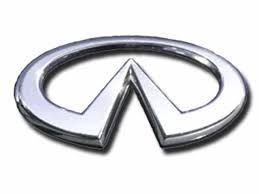FX50 AWD V8-5.0L (VK50VE) (2009)
/Page-1427003.png)
replaced even if the seat belts are not in use during a frontal collision in which the air bags are deployed.
Replace any seat belt assembly (including anchor bolts) if:
-
The seat belt is in use at the time of a collision (except for minor collisions and the belts, retractors, and buckles show no damage and continue to
operate normally).
-
The seat belt is damaged in an accident (i.e. torn webbing, bent retractor, or guide, etc.).
-
The seat belt attaching point is damaged in an accident. Inspect the seat belt attaching area for damage or distortion and repair if necessary before
installing a new seat belt assembly.
-
Anchor bolts are deformed or worn out.
-
The seat belt pre-tensioners should be replaced even if the seat belts are not in use during the collision in which the air bags are deployed.
PRELIMINARY CHECKS
1. Check that the seat belt retractor, seat belt anchor, and buckle bolts are tightened firmly.
2. Check retractor operation:
a. Fully extend the seat belt webbing and check for twists, tears, or other damage.
b. Allow the seat belt to retract. Check that webbing returns smoothly and completely to the retractor. If the seat belt does not return smoothly,
wipe the inside of the loops with a clean paper cloth. Dirt build-up in the loops of the upper anchors can cause the seat belts to retract slowly.
c. Fasten the seat belt. Check that seat belt returns smoothly and completely to the retractor. If the webbing does not return smoothly, the cause
may be an accumulation of dust or dirt. Use the "SEAT BELT TAPE SET" and perform the following steps.
3. Repeat the steps above if necessary to check the other seat belts.
SEAT BELT RETRACTOR ON-VEHICLE CHECK
Emergency Locking Retractors (ELR) and Automatic Locking Retractors (ALR)
NOTE:
All seat belt retractors are Emergency Locking Retractors (ELR) type. In an emergency (sudden stop) the retractor locks and prevents the webbing
from extending any further. All 3-point type seat belt retractors except the driver seat belt also have an Automatic Locking Retractors (ALR) mode.
The ALR mode (also called child restraint mode) is used when installing child seats. The ALR mode is activated when the seat belt is fully extended.
When the webbing is then retracted partially, the ALR mode automatically locks the seat belt in a specific position so that the webbing cannot be
extended any further. To cancel the ALR mode, allow the seat belt to fully wind back to the retractor.
Check the seat belt retractors with the following test(s) to determine if a retractor assembly is operating normally.
ELR Function Stationary Check
Grasp the shoulder webbing and pull forward quickly. The retractor should lock and prevent the belt from extending further.
ALR Function Stationary Check
1. Pull out the entire length of seat belt from retractor until a click is heard.
2. Retract the webbing partially. A clicking noise should be heard as the webbing retracts indicating that the retractor is in the Automatic Locking
Retractors (ALR) mode.
3. Grasp the seat belt and try to pull out the retractor. The webbing must lock and not extend any further. If it does not operate normally, replace the
retractor assembly.
4. Allow the entire length of the webbing to retract to cancel the automatic locking mode.
ELR Function Moving Check
WARNING:
Perform the following test in a safe, open area clear of other vehicles and obstructions (for example, a large, empty parking lot). Road
surface must be paved and dry. Never perform the following test on wet or gravel roads, or on public streets, or highways. This could result
in an accident and serious personal injury. The driver and passenger must be prepared to brace themselves in the event that the retractor
does not lock.
1. Fasten driver seat belt. Buckle a passenger into the seat for the belt that is to be tested.
2. Proceed to the designated safe area.
3. Drive the vehicle at approximately 16 km/h (10 MPH). Notify any passengers of a pending sudden stop and that the driver and passenger must be
prepared to brace themselves in the event that the retractor does not lock. Apply brakes firmly and make a very hard stop.
During stopping, seat belts should lock and not be extended. If the seat belt retractor assembly does not lock, perform the retractor off-vehicle check.
SEAT BELT RETRACTOR OFF-VEHICLE CHECK
1. Remove the rear seat belt retractor. Refer to See: Seat Belt Systems/Seat Belt Retractor/Service and Repair/Rear Seat Belt/Removal and
Installation.
2. Slowly pull out webbing while tilting the retractor assembly forward from the mounted position without twisting the retractor assembly as shown
in the figure.
a. Outer seat belt retractor
